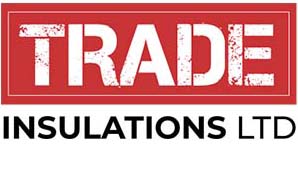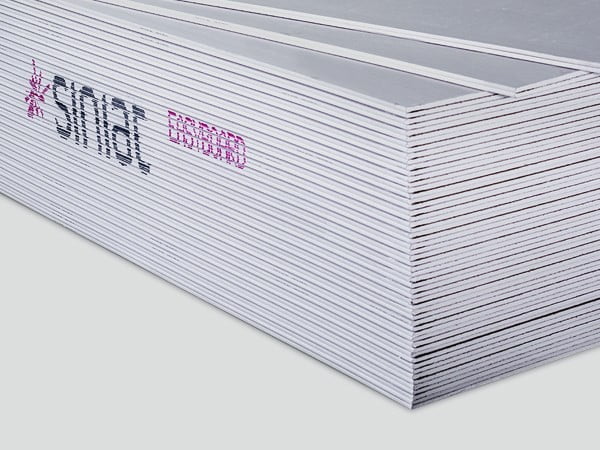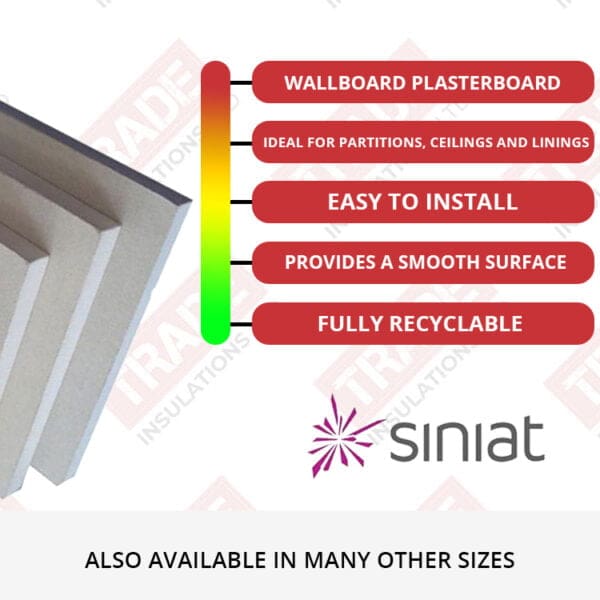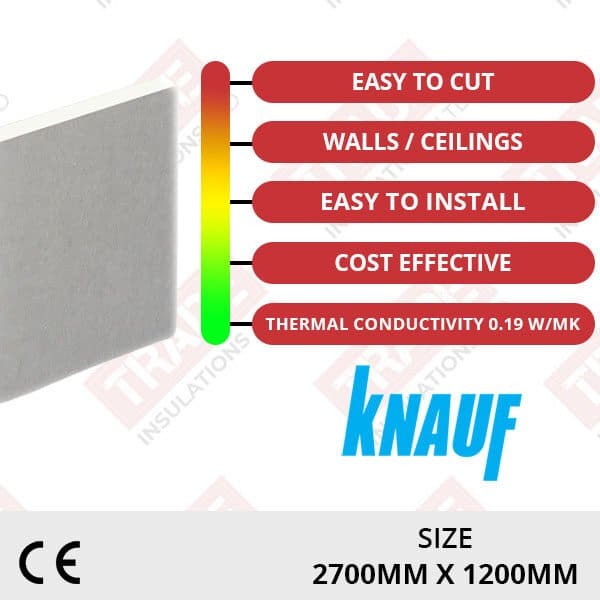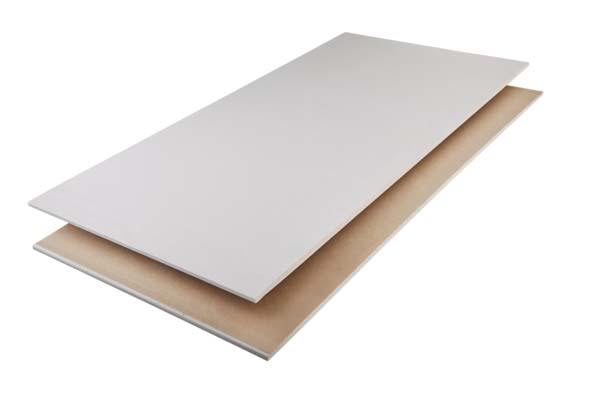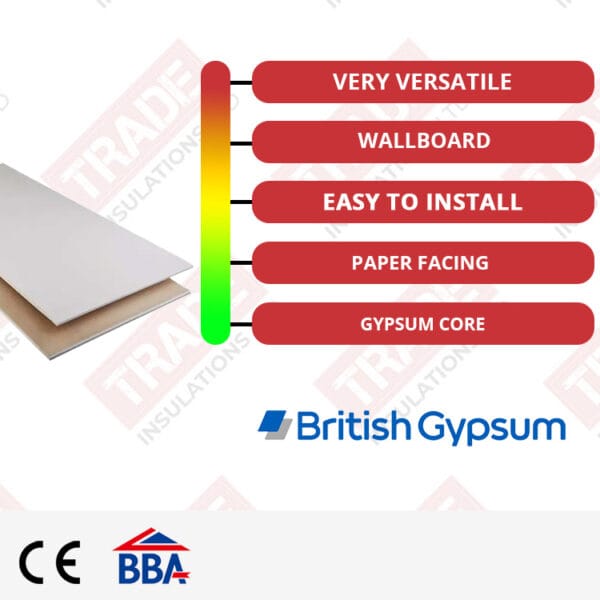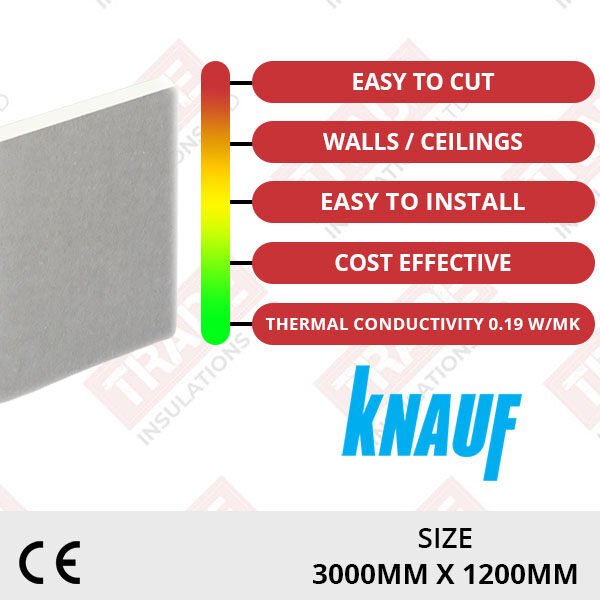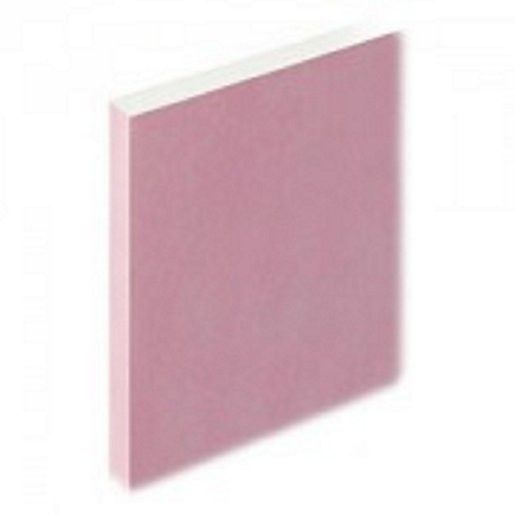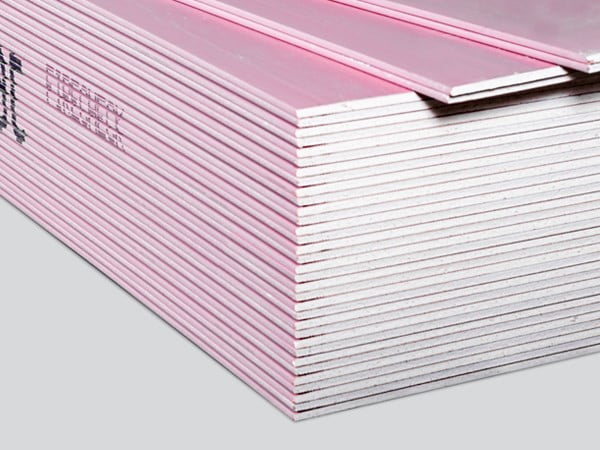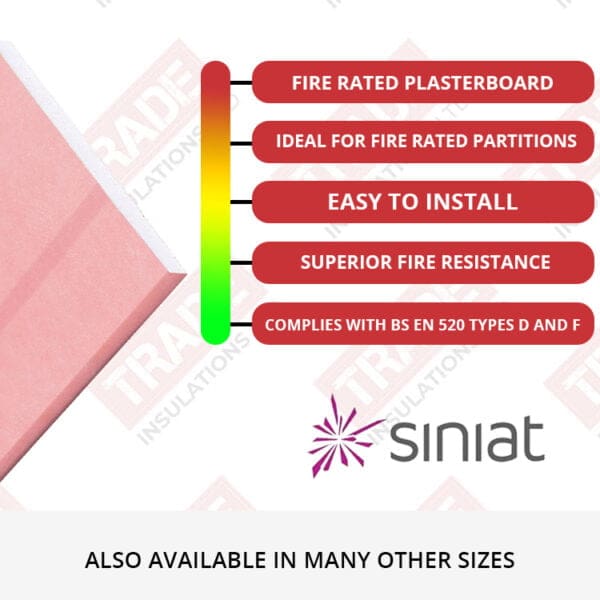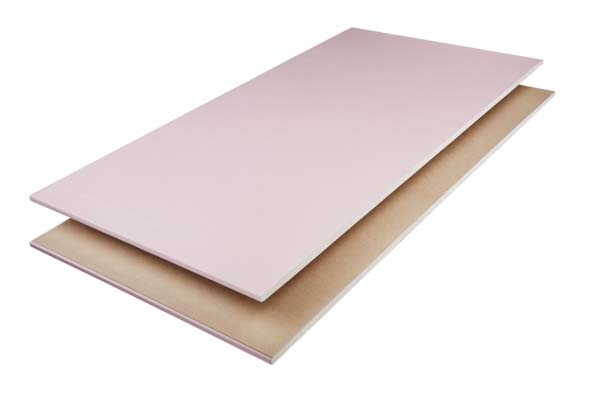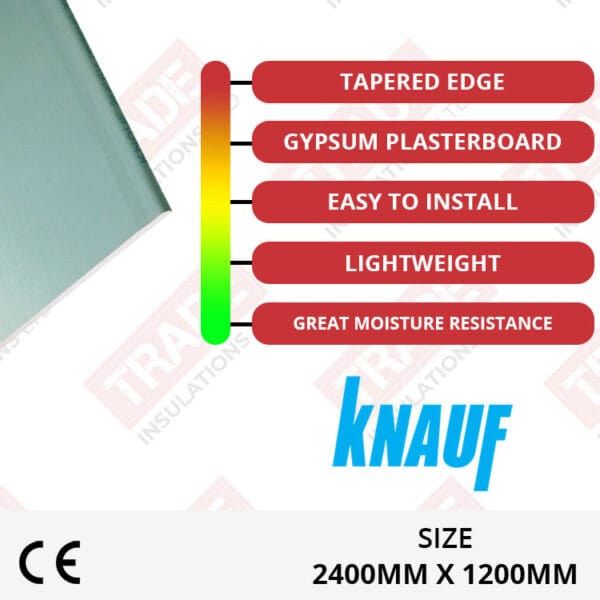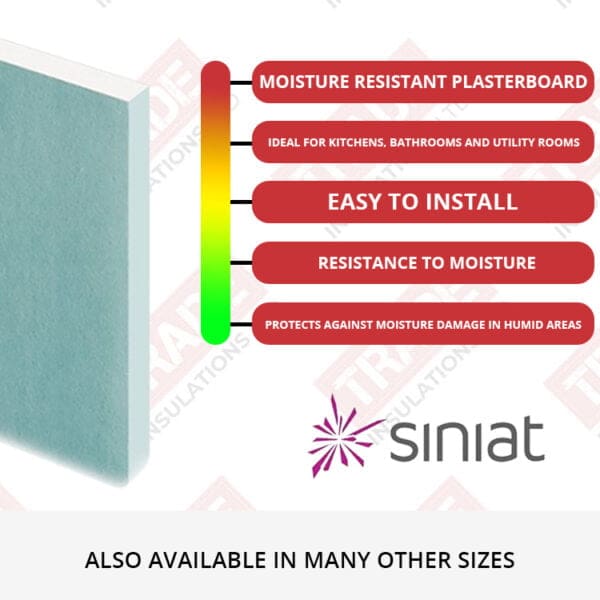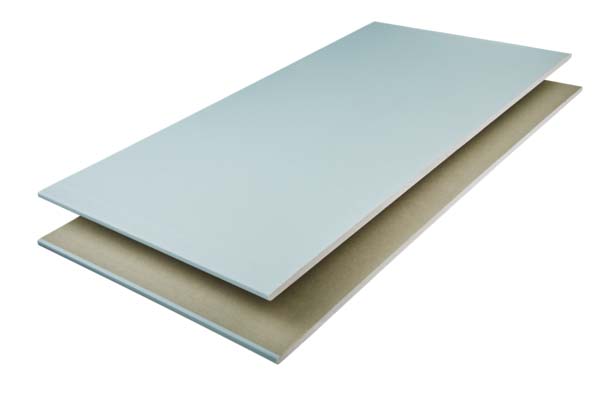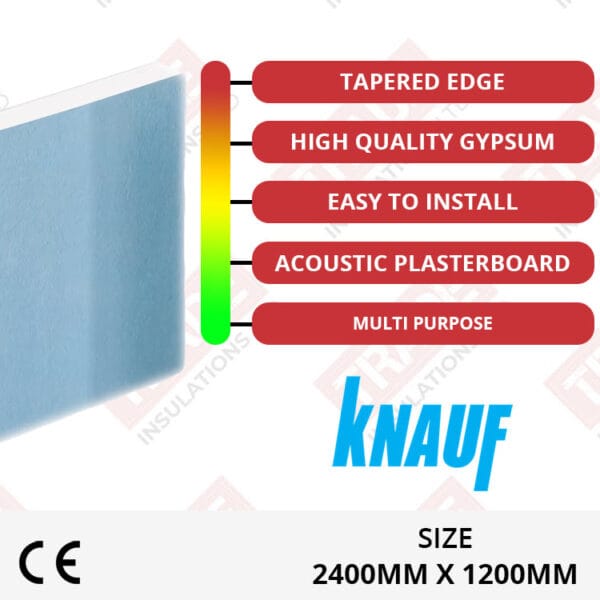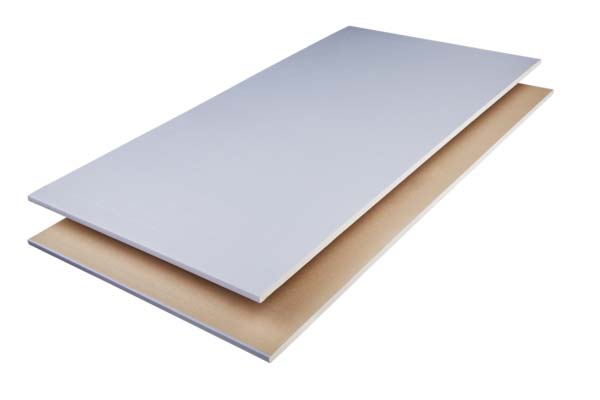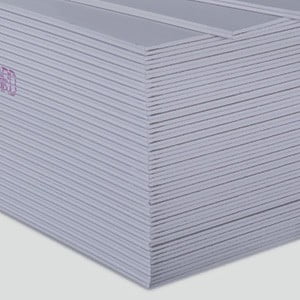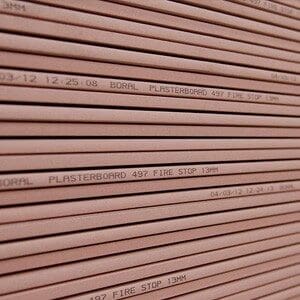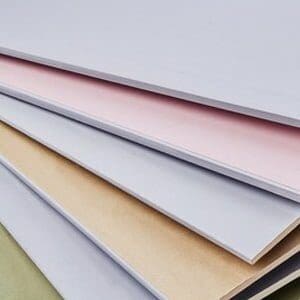Plasterboards are a quick, effective, and versatile way to create walls and ceilings in today’s modern construction and building industry, they are well-known and one of the most popular building materials. Plasterboards are used to help builders, contractors and architects to meet building regulations with their wide selection of materials specialised for fire protection, thermal efficiency, and sound and moisture levels. Plasterboard products are easily cut and decorated with basic tools and a multitude of finishing materials. Most plasterboards contribute to energy efficient due to their recyclable materials that are also made with recycled content. Knauf is one of the leading brand manufacturers of plasterboard products.
You can view all of our plasterboards by heading over to our plasterboard page.
Standard Wallboard
Standard plasterboards are an Ivory board made up of a high-quality gypsum core bonded to strong paper liners on each side made with either a squared edge or a tapered edge. The standard plasterboard goes by several names including gypsum board, wallboard, drywall, or wall panels. Standard wallboards are one of the most popular boards, used to create interior walls and ceilings with a smooth finish ready to decorate. They are easy to cut and install and lightweight to carry. The versatility of the boards means that many options are available once installed such as painting, wallpapering, sealings, taping, and plastering. The standard wallboards are manufactured by well-known and trusted brands within the construction industry including Knauf, British Gypsum, and Siniat.
At Trade Insulations we have Wallboards available in sizes of 2400mm by 1200mm in thicknesses of 12.5mm and 15mm in a square or tapered edge, 1800mm by 900mm in 12.5mm thickness, 2700mm by 1200mm in thicknesses of 12.5mm or 15mm, and 3000mm by 1200mm in thicknesses of 12.5mm or 15mm.
What Is Wallboard Made Of?
Plasterboards are made of Gypsum, otherwise more chemically known as calcium sulphate dihydrate extruded between two thick sheets of paper creating a facer and a backer.
Can You Paint Over Wallboard?
When painting wallboards, the wallboards should be coated with a watered-down primer. The boards are often dry and absorbent, it will be easier to paint once the watered-down layer has been applied. Any chips or digs in the boards may need to be patched up with filler and allowed to dry prior to painting.
You can view all of our wallboards by heading over to our wallboards page.
12.5mm Plasterboard – Knauf Wallboard (12.5mm x 2400mm x 1200mm) (2.88m2) Tapered Edge
Original price was: £10.70.£9.35Current price is: £9.35. ex VATKnauf Plasterboard Wallboard 12.5mm (2400mm x 1200mm) (2.88m2) Square Edge
Original price was: £10.70.£9.35Current price is: £9.35. ex VATKnauf Plasterboard Wallboard 12.5mm (1800mm x 900mm) (1.62m2) Tapered Edge
Original price was: £7.38.£6.45Current price is: £6.45. ex VATKnauf Plasterboard Wallboard 12.5mm (2700mm x 1200mm) (3.24m2) Tapered Edge
Original price was: £12.97.£11.34Current price is: £11.34. ex VATKnauf Plasterboard Wallboard 15mm (2400mm x 1200mm) (2.88m2) Square Edge
Original price was: £13.17.£11.51Current price is: £11.51. ex VATKnauf 15mm Plasterboard Wallboard (2400mm x 1200mm) (2.88m2) Tapered Edge – 8×4 Plasterboard
Original price was: £13.17.£11.51Current price is: £11.51. ex VATKnauf Plasterboard Wallboard 12.5mm (3000mm x 1200mm) (3.6m2) Tapered Edge
Original price was: £15.17.£13.26Current price is: £13.26. ex VATFire Resistant Plasterboard
Fire Resistant Plasterboards are a pink board made of a gypsum core combined with additives such as glass fibre which is bonded between strong paper liners. The additives are designed to withstand high temperatures and resist and prevent the spread of fire. The fire boards have a tapered edge. The different types of pink board will resist fire in different ways, some will be completely resistant to fire while others will resist catching fire for up to 60 minutes. These boards are used for wall and ceiling applications. The fire-resistant plasterboard is also referred to as pink boards, fire panels, fire plasterboards, Fireline plasterboards and fireproof boards. Manufacturers of fire boards include British Gypsum, Siniat and Knauf.
At Trade Insulations we have Fire Rated Plasterboards available in sizes of 2400mm by 1200mm in thicknesses of 12.5mm and 15mm.
What Fire Rating Is 12.5mm Fireline Plasterboard?
Fire resistant boards have a fire rating of class 1 on both sides, which indicates the chances of a flame spreading is at a low rate.
Is Soundbloc Plasterboard Fire Rated?
Sound plasterboard does have a fire rating but not as high as the fire-resistant boards. The Acoustic boards tend to have a fire rating of A2 which means up to one hour of fire resistance.
You can view all of our fire rated plasterboard by heading over to our fire rated plasterboard page.
Knauf Plasterboard Fire Panel 12.5mm (2400mm x 1200mm) Tapered Edge (2.88m2)
Original price was: £13.98.£12.22Current price is: £12.22. ex VATKnauf Plasterboard Fire Panel 15mm (2400mm x 1200mm) Tapered Edge – 2.88m2
Original price was: £17.19.£15.03Current price is: £15.03. ex VATMoisture Resistant Plasterboard
Moisture Resistant plasterboards are a green board with a gypsum core with water-repellent additives within the core that is then faced with paper liners with a tapered edge. The additive is not waterproof but designed to resist atmospheric dampness that you would find in areas such as kitchens and bathrooms. A standard plasterboard installed within a damp environment could deteriorate over time whereas a moisture resistant board will prevent mold and mildew growth. The moisture resistant boards are also known as green plasterboards, moisture resistant drywall, or moisture board. Moisture resistant plasterboards are manufactured by Knauf, Siniat, British Gypsum and many others.
At Trade Insulations we have Moisture Resistant Plasterboard available in sizes of 2400mm by 1200mm in thicknesses of 12.5mm and 15mm.
Is Moisture Resistant Plasterboard Worth It?
Moisture resistant plasterboards are essential for kitchens or bathrooms and wet areas however if you are tiling the boards the tiles will provide moisture-resistance. The boards are recommended in case of circumstances such as future wear and tear where loosened grout may lead to water seeping through to the boards.
Can You Dot and Dab Moisture Resistant Plasterboard?
Yes, moisture boards can be applied to walls using the dot and dab technique using products such as Knauf Drywall Adhesive.
You can view all of our moisture resistant plasterboard by heading over to our moisture resistant plasterboard page.
Knauf Plasterboard Moisture Panel 12.5mm (2400mm x 1200mm) Tapered Edge (2.88m2)
Original price was: £18.14.£15.86Current price is: £15.86. ex VATKnauf Plasterboard Vapour Panel 12.5mm (2400mm x 1200mm) (2.88m2) – Tapered Edge
Original price was: £16.06.£14.04Current price is: £14.04. ex VATKnauf Plasterboard Moisture Panel 15mm (2400mm x 1200mm) Tapered Edge (2.88m2)
Original price was: £22.31.£19.50Current price is: £19.50. ex VATKnauf Plasterboard Vapour Panel 15mm (2400mm x 1200mm) – 2.88m2 – Tapered Edge
Original price was: £21.27.£18.60Current price is: £18.60. ex VATAcoustic Plasterboard
Acoustic plasterboards are a blue board with a gypsum core and other additives such as mineral wool or glass fibre to help prevent noise travelling between rooms by absorbing the sound waves. The board is the bonded to high-quality heavy-duty paper facings. The acoustic boards have a tapered edge. This type of board is often denser than other plasterboard materials due to its acoustic capabilities and is applied to walls and ceilings. The acoustic plasterboard is also known as soundproof plasterboard, Soundbloc, blue boards, sound panels or soundshield. Sound panels can be reinforced and paired with other sound proofing materials such as mineral wool or glass fibre insulation. This product is great for creating quieter spaces in home and office environments including areas where sound reduction is essentials including schools, hospitals, and confidential areas. These sound panels are manufactured by a variety of brands including British Gypsum, Siniat, and Knauf.
At Trade Insulations we have Acoustic Plasterboards available in sizes of 2400mm by 1200mm in thicknesses of 12.5mm and 15mm.
Does Acoustic Plasterboard Work?
Soundproofing plasterboard is one of the most cost-effective ways to reduce noise travelling through your home. Although they will not completely soundproof your home the noise will be reduced and can be reduced by up to 50 decibels.
Is Soundproof Plasterboard Any Good?
Soundproof plasterboards are a great product to reduce sound vibrations. Impact noise such as something hitting to the wall may not always be effectively blocked. Soundproof boards are also a great product to use when applying acoustic insulation such as Knauf acoustic rolls.
You can view all of our acoustic plasterboard by heading over to our acoustic plasterboard page.
Knauf Soundshield Plus 12.5mm Plasterboard (2400mm x 1200mm) Tapered Edge (2.88m2)
Original price was: £16.64.£14.55Current price is: £14.55. ex VATKnauf Soundshield Plus 15mm – Soundshield Plus Panel – (2400mm x 1200mm) Tapered Edge – 2.88m2
Original price was: £21.00.£18.36Current price is: £18.36. ex VATVapour Panels
Vapour panels are a silver and grey board is made up of a high-quality gypsum core and paper linings on each side with an additional metallised polyester foil liner on the back. This enhances the vapour resistance of the material. This board is available in a tapered edge. The vapour panels are often used in areas where humidity and moisture are a cause for concern such as bathrooms and other typically wet areas. The purpose of the vapour barrier is to prevent condensation escalating into issues that could cause problems to the structure of the building. Vapour panels are also referred to as vapour board, vapour check, foil backed plasterboard or vapour plasterboard. Vapour panels are manufactured by many well know manufacturers including Knauf.
At Trade Insulations we have Knauf Plasterboard Vapour Panels available in sizes of 2400mm by 1200mm in thicknesses of 12.5mm and 15mm.
Can You Dot and Dab Vapour Plasterboard?
Foil backed plasterboards are not made for dot and dab applications and should be applied using mechanical fixings such as screws. This is due to the bond between the foil and the board not being strong enough.
Do I need foil backed plasterboard?
Foil backed plasterboard is for internal applications when renovating or building a property with the intention of reducing risk of moisture issues developing over time such as damp or mould.
You can view all of our Knauf vapour panel plasterboard by heading over to our Knauf Vapour Panel Plasterboard page.
Knauf Plasterboard Vapour Panel 12.5mm (2400mm x 1200mm) (2.88m2) – Tapered Edge
Original price was: £16.06.£14.04Current price is: £14.04. ex VATKnauf Plasterboard Vapour Panel 15mm (2400mm x 1200mm) – 2.88m2 – Tapered Edge
Original price was: £21.27.£18.60Current price is: £18.60. ex VATHow Thick is Plasterboard?
Plasterboards in the UK are generally available in thicknesses of 9.5mm, 12.5mm, and 15mm. Consult you builder or architect to identify the thickness you need for your project.
How Many Mist Coats on New Plasterboard?
Only one mist coat should be required when painting over plasterboard however the mist coat should be left to dry for around 24 hours even if the board should feel dry before this. If you should have left-over watered-down paint, a second coat of mist paint can be applied if you would prefer after the first coat is set and dry.
If you are looking for plasterboards, be sure to purchase them from our website.
